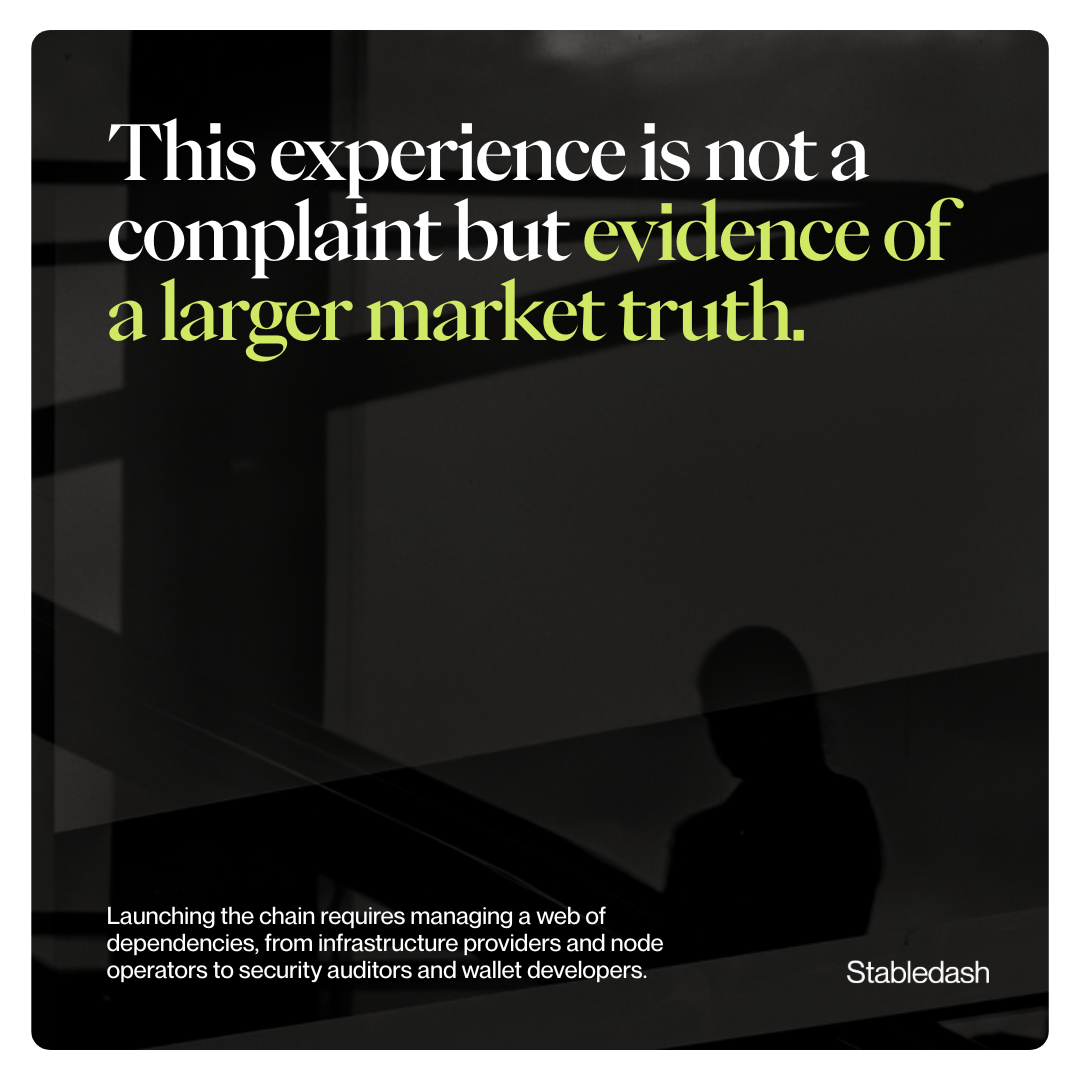Stabled Up by The Rollup
The End of the Launch Era: Why 'Scale' Is Shifting from Chains to Ecosystems
A mainnet launch is no longer the finish line for blockchain projects. Industry analysis reveals that true, defensible scale is now defined by the ability to build an integrated, multi-product ecosystem that anticipates the market's inevitable convergence.
October 7, 2025

The Definition of Blockchain Scale Is Changing
The blockchain industry is at a critical inflection point where the very definition of success is being rewritten.
As one project lead, Paul, noted after a recent launch, "what at scale means now I think won't mean at scale in two three four five years."
This observation captures a fundamental shift in market dynamics. The 2020-2023 era was dominated by a race for raw performance, where "scale" was narrowly defined by a single chain's transactions per second (TPS), low gas fees, and time-to-finality.
Today, that model is becoming obsolete. Analysis of market trends and expert commentary indicates a clear pivot. The new benchmark for scale is a network's capacity to orchestrate a complex, integrated system of products. This creates a sticky, defensible ecosystem that generates value far beyond the base layer.
As the industry matures, the traditional mainnet launch, once celebrated as a project's culmination, is now understood to be merely the starting gun. The real race is to build a cohesive, multi-product ecosystem that provides compounding value to users and developers alike.
Part 1: The Launch as a Foundation
A Look Inside an Intense Mainnet Launch Week
The process of bringing a new blockchain online provides a powerful illustration of the industry's evolving complexity. Reflecting on a recent mainnet deployment, Paul described the experience as "intense." This intensity stems from coordinating "so many external variables that are like not fully within your control."

This operational challenge highlights the immense scale of the true objective: orchestrating an entire network of interconnected products. If deploying the foundational layer is this strenuous, building a multi-faceted ecosystem on top of it represents a challenge of a completely different magnitude.
A Chain Launch Is Only the First Step
The prevailing myth in the crypto industry has long been that a mainnet launch is the moment of arrival. When asked if the most difficult part was over, Paul's response was a direct refutation of this idea: "No, not at all."
This perspective is increasingly validated by market data. A successful launch provides a secure settlement layer, but it generates no value in isolation. It is the foundational infrastructure upon which a project's true vision must be built.
Industry experts now emphasize that the post-launch period is often more critical than the pre-launch phase, as projects must shift focus to fostering a vibrant ecosystem of dApps, services, and active users. The "build it and they will come" mentality is no longer sufficient for long-term success.
Why the Real Work Begins After Mainnet
The post-launch phase marks the true start of value creation. As Paul puts it, this moment is "the beginning of of actually kind of truly building what we've always set out to to to build." This "real work" moves beyond base-layer metrics and into the sophisticated realm of ecosystem architecture.
From an analytical standpoint, this work can be broken down into several key strategic pillars:
- Product Integration: This involves architecting the technical and economic connections between distinct components, such as a core chain, a DeFi ecosystem, and an exchange product. The goal is to create a seamless user experience where value flows frictionlessly between applications.
- Developer Adoption: Attracting and retaining talent requires more than just a fast chain. It demands robust tools, clear documentation, and well-designed incentive programs that encourage builders to leverage the entire ecosystem, not just a single feature. The growth in experienced, multi-chain developers—now one in three, according to 2024 reports—shows that builders are seeking rich environments.
- Liquidity and Value Accrual: A successful ecosystem strategy involves strategically seeding and growing value across its integrated products. This moves the focus from isolated Total Value Locked (TVL) on a base layer to measuring the velocity of assets and data moving between different parts of the stack.
- Community Governance: As ecosystems grow, they require sophisticated governance frameworks that can manage a multi-product system, ensuring alignment and sustainable growth.
Part 2: Building the Integrated Ecosystem
Plasma One Is the First Piece of a Larger Vision
To understand the ecosystem-first mindset in practice, one can look at the strategic deployment of modular components. The announcement of a product like Plasma One before its underlying chain is even live exemplifies this approach. It positions the product not as a standalone feature but as the first functional module in a much larger system.
The strategic role of such a component is to serve as a bridge, enabling and enhancing the capabilities of other parts of the ecosystem, such as the DeFi and exchange components Paul alluded to. It answers the critical question for any builder: "How do we begin constructing an integrated stack that is more than the sum of its parts?" This approach treats each product release as a deliberate step toward a unified, multi-product vision.
Future Success Requires an Integrated Ecosystem
Building an integrated ecosystem delivers significant and defensible competitive advantages that a single-product chain cannot replicate. The research on this model is compelling, highlighting three core benefits:
- Compounding Network Effects: An integrated stack where a chain, DeFi protocols, and exchange services share liquidity, user identity, and data creates powerful, compounding network effects. As seen with the rise of EVM-compatible chains, where 74% of multi-chain developers are active, a shared and interoperable environment attracts and retains talent and users, increasing the value of the entire ecosystem for all participants.
- Superior User Experience: The next wave of "real world" users will not tolerate the fragmented and complex experience of navigating multiple chains and protocols. An integrated stack can abstract away this complexity, providing a unified and intuitive interface that is essential for mass adoption.
- Enhanced Defensibility: In an industry where open-source code can be forked, a standalone L2 focused solely on speed or cost is vulnerable to commoditization. An integrated ecosystem, however, builds a deep strategic moat. The combined network effects, shared liquidity, and unified user base are far more difficult for competitors to attack or replicate.
Part 3: The Future of a Converged Market
Technology Layers Will Blend Together in 2 to 5 Years
Looking ahead, the market is poised for a period of profound convergence. Paul predicts that within the next two to five years, distinct technology layers are "going to blend together into this whole broader landscape of this tech stack." This isn't just a theoretical observation; it's a strategic forecast supported by clear industry trends.
This "blending" will manifest in tangible ways, fundamentally altering the user and developer experience:
- Shared Infrastructure: We will likely see the rise of shared sequencing and settlement layers across multiple L2s, creating a more unified and secure blockspace market.
- Seamless Interoperability: Cross-chain messaging protocols will become increasingly sophisticated and invisible to the user, allowing for the fluid movement of assets and data between once-siloed ecosystems. The fact that the number of multi-chain developers has grown from under 10% in 2015 to 34% in 2024 underscores the demand for this interconnectedness.
- Economic Convergence: A single token may soon be used to govern or provide economic security for multiple, distinct layers of a tech stack, creating powerful new models for value accrual and alignment.
Competition Is Shifting to Integrated Tech Stacks
This predicted convergence is already reshaping the competitive landscape. The basis of competition is rapidly shifting away from isolated chains and toward fully integrated tech stacks.
Consider the strategic positions of different market players. A project focused only on being the "fastest" or "cheapest" L2 is competing on metrics that are becoming commoditized. In contrast, ecosystems like Ethereum, with its vibrant network of L2s like Arbitrum, Optimism, and Base, demonstrate the power of an integrated, multi-layer approach.

Base, for example, captured 28% of all new crypto startup activity in its first year, a testament to the power of its integration with the broader Coinbase ecosystem. These integrated systems are creating deeper moats and proving to be more resilient and attractive to both developers and capital.
Conclusion: Measuring What Matters
Key Metrics to Watch in a Post-Launch Environment
If the definition of scale is changing, then the metrics used to measure it must also evolve. For founders, investors, and developers, relying on outdated benchmarks like TPS or raw developer counts is no longer sufficient. To accurately assess a project's long-term potential in a post-launch environment, the focus must shift to metrics that reflect true ecosystem health.
Here are three actionable metrics that offer a more accurate indicator of sustainable value:
- Developer Gravity: Instead of counting total developers, measure the percentage of developers who are utilizing more than one component of the ecosystem's stack. This metric reveals how effectively a project is creating integrated value and fostering a sticky environment for builders.Cross-Product Value Flow: Move beyond simple TVL and track the volume of assets moving between the ecosystem's distinct products. High velocity indicates strong integration and genuine utility, showing that users are engaging with the full breadth of the platform.Integrated User Retention: Analyze the retention rate of users who interact with two or more products versus those who only use one. A significantly higher retention rate for multi-product users is a powerful signal of a strong product-market fit and a defensible user base.
The Strenuous Work Is Building the Vision
The journey of building in the blockchain space is often misunderstood. As Paul observed, the "most strenuous part is is ahead of us now." The mainnet launch was the foundational step, but it was also the easy part.
The strenuous, valuable, and ultimately defensible work is the long-term, deliberate process of architecting and executing an integrated, multi-product vision. As the market continues to mature, success will be defined by those who understand this shift. For the builders and investors looking to create lasting value, the path forward is clear: focus on building and measuring the health of the entire ecosystem, not just the performance of a single chain.
Don't Miss the Next Big Shift
The Stabledash newsletter keeps you off the timeline and dialed into modern money.
Join leaders at Circle, Ripple, and Visa who trust us for their stablecoin insights.



